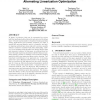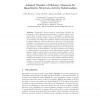627 search results - page 5 / 126 » Structural Learning of Activities from Sparse Datasets |
ECCV
2010
Springer
14 years 29 days ago
2010
Springer
Sparse coding of sensory data has recently attracted notable attention in research of learning useful features from the unlabeled data. Empirical studies show that mapping the data...
ECCV
2010
Springer
13 years 12 months ago
2010
Springer
Abstract. Much recent research in human activity recognition has focused on the problem of recognizing simple repetitive (walking, running, waving) and punctual actions (sitting up...
KDD
2010
ACM
13 years 10 months ago
2010
ACM
In plenty of scenarios, data can be represented as vectors mathematically abstracted as points in a Euclidean space. Because a great number of machine learning and data mining app...
BIBE
2008
IEEE
13 years 10 months ago
2008
IEEE
Bayesian network structure learning is a useful tool for elucidation of regulatory structures of biomolecular pathways. The approach however is limited by its acyclicity constraint...
DIS
2010
Springer
13 years 7 months ago
2010
Springer
Quantitative structure-activity relationships (QSARs) are regression models relating chemical structure to biological activity. Such models allow to make predictions for toxicologi...


